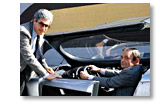
Giugiaro is quick to point out that Mantovani never, never says “no” to a new idea.
An idea may in fact be impossible to realize, but Mantovani will only say so after he and his competent and innovative engineering staff have made a concerted effort to implement it. That, says Giugiaro, is in sharp contrast to the reflexive negative reactions he so often receives from engineers at client firms.
More often than not, though, Mantovani comes through with solutions that advance the art of automobile body design for the whole industry. The so-called “autoclave” doors extending into the roof were refused by Ing. Fiala of Volkswagen, but were made to work by Mantovani, and you can see them on any number of cars today.
Italdesign is not a production house, unlike its older design competitors, Bertone and Pininfarina, both descended from the Italian coachbuilding tradition, both involved today in important series-production projects. The only car sold to the public with a body that was completely built by Italdesign was the 1978 BMW M1, and there were only a few hundred of those. Twenty-five replicas of the Audi-powered 1988 Aztec sports car were built for the Japanese market, but not by Italdesign itself.
On the other hand, Italdesign did build more than 100 conforming prototypes of the Daewoo Lanos, and with its capacity of three complete prototypes per week, Italdesign could very well undertake the series production of a car like the W-12 coupe and roadster it designed for Volkswagen last year. In fact, Giugiaro makes no secret of the fact that he would very much like to do that niche manufacturing for VW.
Asked to name his own favorites among the many cars created in the past thirty years, Giorgetto Giugiaro – not at all surprisingly – names the original Volkswagen Golf as number one, just as he did ten years ago in Auto & Design 49. He does so not just because it replaced an icon and became one of the most successful cars of all time through four generations inspired by its crisp, no-nonsense style, but because it also represents a major change in Giugiaro’s own formal ideas. “The Golf is directly derived from the Mangusta, you know,” said the maestro. “Come, I’ll show you.” In the not-yet-complete Italdesign museum he ran his hands over the front fender crown and up the windshield pillar. “You can see that the light moves up the pillar, not along the door, exactly as in the Mangusta.” And, of course, it does.
Giugiaro went on to explain that the De Tomaso Mangusta he created at Ghia represented a conscious effort to move away from the sensuous curves of the Bertone house style he had helped develop, perhaps most perfectly in the Alfa Romeo Canguro, still a favorite of other car designers after more than 30 years.
The Golf came along at a perfect sociological time. Because of the Arab petroleum embargo in the Seventies, many wealthy drivers elected not to buy the big cars that they normally would have chosen, and instead took the VW because of its style and quality.
The museum car on which Giugiaro demonstrated his design intentions for us is a first- series Golf GTI with four doors, built at his personal request, and then replicated by VW only once, for the orchestra conductor Herbert Von Karajan. But it was the hundreds of thousands of other Golf owners who made it clear that this was a critically important design. Curiously, it might never have happened at all.
In 1969 the then-president of VW, Kurt Lotz, toured the Torino motor show, noting the cars he liked and picking six as inspiration for forthcoming VWs. When he discovered that four of the six were Giugiaro designs, Italdesign’s participation in the new VW model program was set. There was the first Passat in 1973, and then a car that was expressed by the president as needing to be “more modest than the Fiat 128.” Essentially there were two Golf-like cars under development, a big one and a little one, when Herr Leiding took over the VW presidency and tossed out the entire program, save for the Golf we all know now.
That design would have been cancelled, too, because, said Leiding, “that can’t work, but it’s too late to change it.” It is certainly fair to say that Leiding’s luck was far superior to his design judgement. Without the success of the Golf, Volkswagen could well have disappeared, the state of the company having been so precarious with noth-ing but Thirties-think rear-engine cars to sell.
The article continues in Auto & Design no. 109










